News & Blogs
“Oyose chakai (大寄せ茶会)”: a large casual tea gathering is for everyone.
Join me for a casual tea gathering in memory of Lord Kobori Enshu.
Memorial services dedicated to Lord Enshu and the dearest tea whisks (茶筅 chasen)
Read the details and imagine the theme of today’s tea ceremony.
In this blog, we touch on diverse topics about Japanese food cultures, practices together with the culinary secret, TREHA®, and its important role in the Japanese food industry. We hope our blog helps you obtain in-depth knowledge of the secrets and science behind Japanese cuisine, shared from our kitchen, to yours.
This article is dedicated to the late Sensei S. T. who taught me not only the formalities but also the true sense of hospitality and respect to others through the Japanese tea ceremony. I feel genuinely grateful and fortunate that he guided me through the world of this ancient Japanese tradition since the first day I stepped into it. Although a decade has passed since he left this world, a feeling of remorse occurs to me because I was not able to reciprocate him for the most valuable life lesson I received while he was present. I am hoping to express the deepest gratitude to my most admired sensei by sharing what he had taught me with the world.
Now that you can prepare delicious matcha green tea by yourself after reading the previous article, why not make your debut in joining a large tea gathering (大寄せ茶会 oyose chakai)? The tea gathering is open to the public, meaning anyone can attend.
Oyose chakai (大寄せ茶会) is a large-scale casual tea gathering event held at places like temples equipped with large capacities and historical value. Anyone with or without Japanese tea ceremony experience can participate with purchased tickets as with movies and live concerts including the part that advance tickets are cheaper. Kids are welcome as long as they don’t bother other guests during the ceremony. Since the ceremony lasts for a short time, about 20-30 minutes per session, oftentimes even a mischievous kid can hold off thanks to the magic of delicious sweets. Since the tea gathering features multiple tea ceremony schools, it offers a valuable cause to attend ceremonies hosted by different schools. For those who are learning and practicing tea ceremonies, seeing the performance of other schools is a precious learning opportunity.
There is no problem even if you don't know the rules and etiquette of the tea ceremony, or if you don't have the tea ceremony accessories or items. In addition, it's okay if you're not good at sitting down on the floor in a seiza position folding legs underneath thighs. You will receive a chair to sit on when you request in advance. The purpose of the tea ceremony is to have a good time through delicious tea, so relax and enjoy.
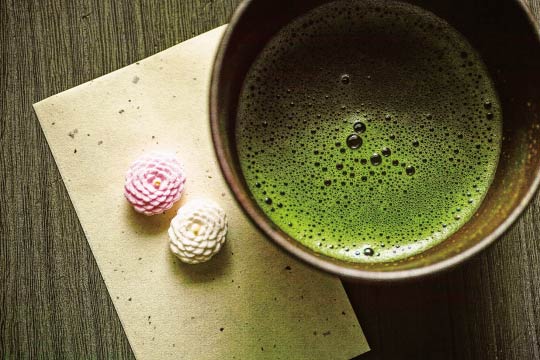
Meet me at the temple: a large casual tea gathering held in memory of Lord Enshu Kobori.
I am guiding you on an imaginary tea gathering tour, oyose chakai (大寄せ茶会) memorial ceremony for Lord Enshu Kobori on November 2021.
Imagine we meet up at Raikyuji Temple in Takahashi City, Okayama Prefecture. It belongs to the Rinzai sect, which is one of three sects of Zen in Japanese Buddhism, famous for its beautiful Zen garden awarded one star in Michelin Green Guide Japon designed by nobody but the Lord Kobori Enshu. I’m very glad you are here with me. Let us purchase walk-up tickets to the site. It is about USD 17.50 (2,000 yen) which includes the admission fee for the garden, two ceremonies, and a dim sum. It is a fantastic package! I vouch you will love the memorable experiences. Are you ready to visit the garden?
A lush emerald Japanese garden framed with autumn colors awaits us. The slightly moist wind gently tickles our cheeks while tossing maple leaves, which just departed their domain for the season. Let’s sit down and take a look at the garden because we still have some time before the ceremony starts.
The garden features the traditional “dry” landscape. This renowned garden is called "鶴亀の庭 (Tsurukame no Niwa, the garden of crane and tortoise)". It was named after the rock formations representing lucky symbols of cranes and tortoises. The garden designing principle of incorporating background landscape into the garden composition is diligently followed by the distant view of Mt. Atago. The large trimmed azaleas bushes represent the waves of the ocean garnished by the white sand depicting the ocean ripples. Pretty neat, isn’t it? This gorgeous hedge design is unique to Enshu gardens.
Do you want to know about Lord Enshu who designed the garden? He was, in fact, a talented samurai in many ways.
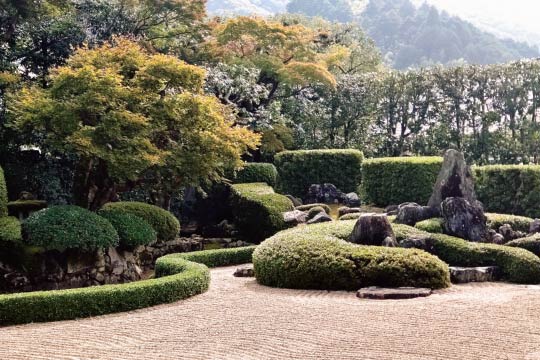
Lord Kobori Enshu (1579-1647) served as the local magistrate in the early Edo period.
In addition to the garden of this temple, Lord Enshu supervised several architectures such as the garden of Nanzenji Temple (Kyoto), Nagoya Castle (Aichi Prefecture), and Sunpu Castle (Shizuoka Prefecture), which are also Japan’s sightseeing destinations.
Load Enshu excelled not only in architecture but also in the world of the Japanese tea ceremony. When a young child, Enshu was familiarized with Sen no Rikyu (千利休, 1522–1591), who is the most profound influencer in the Japanese tea ceremony history. Enshu was highly impressed by Rikyu’s demeanors.
At the age of 17, Enshu studied under Lord Oribe Furuta, feudal lord, one of Rikyu's disciples, and a famous tea master. Later Enshu was appointed the official tea ceremony instructor for the 3rd Tokugawa shogun, Iemitsu, and became the progenitor of the Enshu tea ceremony school (遠州流 Enshu-ryu).
Today’s large casual tea gathering here is a homage to Load Enshu. The tea ceremonies are hosted by two schools consisting of the Enshu School (遠州流) and Urasenke School (裏千家).
Before the ceremonies, there seems to be a memorial service dedicated to Lord Kobori Enshu. This is a rare opportunity to observe a traditional ritual by Japanese Buddhism. Let's be part of it. The chief priest chants the sutra for the late Enshu’s spirit and safety of today’s gathering. Representatives of Urasenke and Enshu-ryu Schools make an offering of a bowl of matcha respectively. I am sure Lord Enshu's spirit is happily watching over the event.
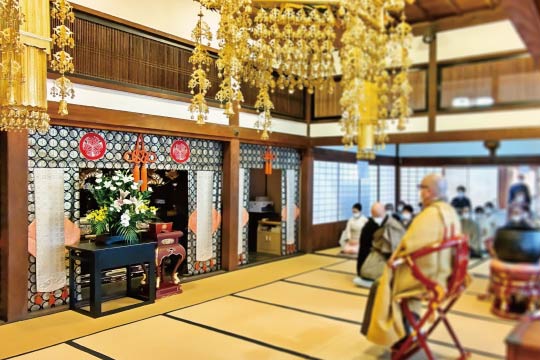
Thank you, and R.I.P. bamboo whisks
Meanwhile outside, the requiem service for tea whisks (茶筅供養 chasen kuyo) started. Wait for a minute, a requiem service for TEA WHISKS? Yes, you heard it right.
The service is to thank the tea whisks that are worn out and no longer used. As the priests read the sutras aloud, the participants place the old whisks in the sacred fire one by one with gratitude.
In Japan, it is not unusual to hold a requiem service for the daily items which completed their duties. A similar service is conducted to thank broken needles (針供養 hari kuyo) and used brushes (筆供養 fude kuyo) and so on. We have the custom to treat everyday tools with care as if they were living objects. After fulfilling their services, we treat them with gratitude and respect before disposing of them.
Do you smell incense burning together with the whisks? Don’t you think this is a very proper farewell to the hard-worked whisks?
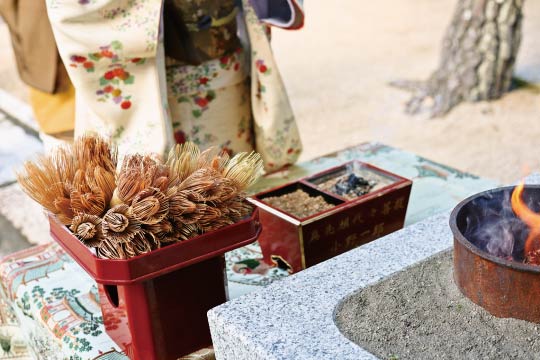
Get ready for the ceremony in the waiting area (待合 machiai).
The memorial services to Lord Enshu and tea whisks make us feel somewhat solemn and reflective. Last, but not certainly least, a tea ceremony is a few minutes away. Hand a ticket to the kind-faced receptionist who is guiding to the waiting room (待合 machiai). This is the time you make a special request like a chair to sit on alternative to sitting on the floor, or borrowing special gadgets (such as napkins, a fan for greeting, a small knife to cut sweets) to make you more comfortable in the ceremony.
The waiting room is a place where guests meet and get ready for the tea ceremony. It is also called yoritsuki (寄付). In the waiting room, there is a hanging scroll and chakaiki (茶会記 the records of the tea ceremony) in the alcove, and hakogaki (箱書description written on tea utensil's case). Let's take a look!
For the alcove of the tea room, it is a rule is to hang a white scroll painted in black ink. On the other hand, there is no particular rules for the type of painting in the waiting area. Generally, a scroll reflecting the host’s taste such as seasonal flowers and general calligraphy is chosen.
Chakaiki (茶会記) is a record of the ceremony. The name, date, and purpose of the ceremony are indicated along with the descriptions of creators’ names for utensils used. It's very similar to the restaurant menu, describing ingredients and cooking methods.
Hakogaki (箱書) is the letters written in ink on the lid of a paulownia or cedar box to store utensils such as matcha bowls. The descriptions include the type of pottery (such as “Hagi” or “Bizen”, for example,) the type of pottery (tea bowl, water container, and so on), and the name of the creator. The poetic name for the tool, "銘 mei" could be included in the descriptions. "銘 mei" is an honorific name given to excellent tea utensils. The most famous example is "Tears (泪 namida)" given to the tea scoop. Sen no Rikyu created and named this scoop after being ordered to seppuku by Toyotomi Hideyoshi, who was in power at the time. He used the scoop for his final tea ceremony and gave it to his disciple Lord Oribe Furuta, whom Lord Enshu studied under. The hakogai (箱書) contents are repeated in the chakaiki (茶会記) record in modern fonts and styles, thus you will learn about the details even when the original hakogaki handwritings are too ornate or classic to read.
At tea gatherings, whether formal or informal, utensils convey the host's solicitude and satisfy the guests. Before you enter the tea room, check the ceremony details, read the descriptions of the utensils, appreciate original handwritten notes possibly by the creators, a hanging scroll selected with the host’s taste. All of this would help you identify the theme of today’s tea ceremony, making you excited about the upcoming ceremony!
While doing so, it appears that the host is now ready to start. Let's walk over to the tea room. Next time, let's have matcha in the tea room.
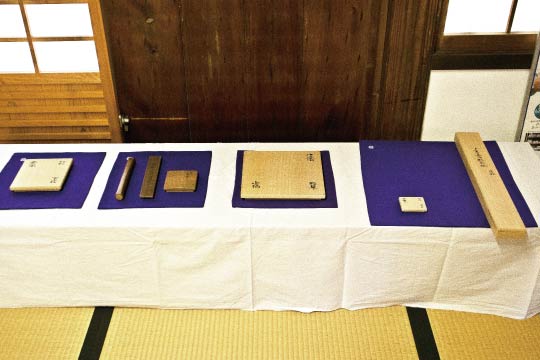
Did you find this blog interesting?
Please share it with your friends in the food service industry.
We regularly update the blog about the food culture of Japan, where TREHA® was discovered for culinary applications.
Click here and send us a message to subscribe.
Or hit us up on Instagram @trehalose_sensei!
You might also be interested in:

